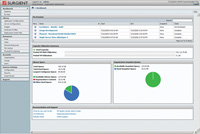Private Cloud Automation
Up and running in 30 days wih Surgient Cloud Express.
Surgient Cloud Express promises to deliver an on-premises (private) cloud in just 30 days. Cloud Express includes Surgient's patented cloud software components, documentation and implementation services for $50,000 -- a cost Surgient claims several of its customers have recouped in less than 30 days.
Surgient Cloud Express is a software/services package that integrates with existing servers, storage and networks. It includes:
- The Surgient Platform for 30 managed CPUs (the number of managed CPUs can be grown incrementally)
- Client-specific private cloud architecture
- Implementation services
- Administrator training
- Documentation
- One-year standard support
- ROI tracking and analysis
Cloud Express works with both Microsoft Hyper-V and VMware, and is said to be highly scalable up to thousands of VMs. The foundation of Cloud Express is the Surgient Platform version 7. Cloud Express provides virtualization and automation services that automate the delivery of IT services, including policy-based resource allocation, a self-service portal for reservations and scheduling of IT resources, dynamic capacity management, and the facility for charge-backs and pay-for-service. It is these characteristics that enable a virtualized environment to become a private cloud.
'Timesharing' Virtualized Environments
What make Surgient unique are the elements of its patented technology that create a kind of "timesharing" of the virtualized environment. These elements are constantly monitoring provisioning activities and dynamically managing the allocation of compute resources, storage capacity, software licenses, and, through an end-user portal, are fixing reservations against available assets. Unlike other available provisioning solutions, Surgient enables users to add/remove one or more additional servers to a live, deployed service without causing downtime. Customers can add servers to a live service to dynamically address spikes in user demand and remove servers when demand declines to save operating expenses.

[Click on image for larger view.] |
| Figure 1. Cloud Express provides on-demand virtualization infrastructure that can be used for a range of applications. |
The Surgient Platform can scale to manage many servers in addition to the thousands of VMs, providing capital and operating expense gains beyond the benefits of virtualization alone. One client, a multi-billion-dollar information management firm, added Surgient to its existing large-scale virtualized infrastructure. With Surgient, the customer can automatically deploy environments of 200-plus VMs per instance in five hours, down from two weeks, while reducing service provisioning time by 95 percent. The firm is now able to achieve 2,000 VMs in a single service instance -- in much less time and with lower investment.
Where Surgient's Cloud Express excels as a private cloud offering is in management functionality. One of the biggest challenges IT managers and administrators face when deploying VMs in cloud environments is managing the sprawl caused by large numbers of VMs. Surgient's software environment focuses on returning unused VMs residing in clouds back to a cloud resource pool where those resources can then be used by applications looking for processing power. By returning resources to the cloud, IT managers are able to get higher utilization out of their existing servers -- providing better ROI on servers their enterprises already own. By maximizing resource utilization, it's easy to see why some organizations are recouping their investment in Surgient Cloud Express in 30 days or less.
Another standout feature of the Surgient Cloud Express offering is its policy-based provisioning environment. IT managers and administrators can predetermine which applications are entitled to computing resources -- and create automated policy scripts that ensure that priority applications get access to the resources they need before less-important applications are given resources. This automated, priority-driven provisioning of resources eliminates the need for human intervention when assigning computing resources, helping drive down operational costs and bolstering ROI.
About the Author
Jane Clabby has been in the IT industry for over 25 years in a range of marketing, research and business development roles. Currently a research analyst at Clabby Analytics, Jane focuses on storage and storage management, and cloud computing.